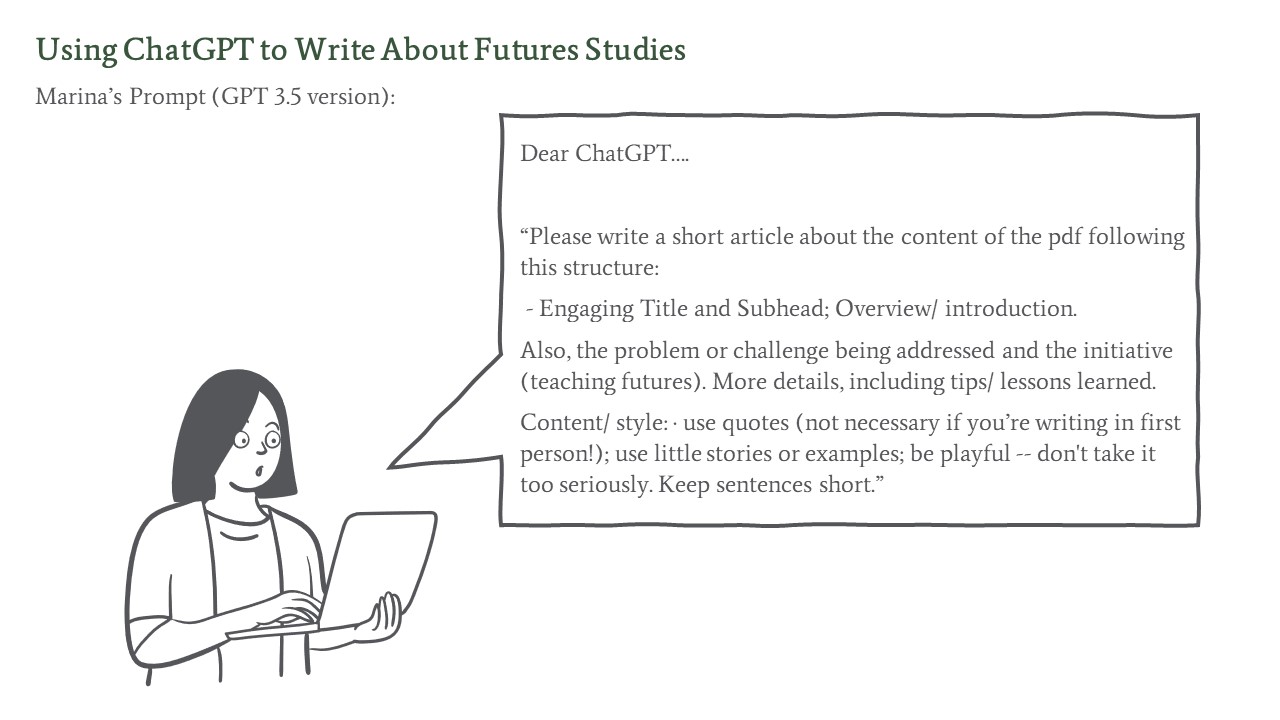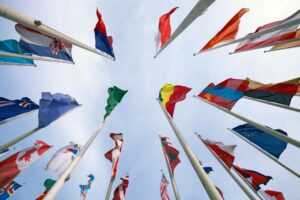Tomorrow’s leaders need new visions of the future. Marina Schmitz shares insights from her course merging futures studies and sustainability.
Marina Schmitz is Researcher and Lecturer at IEDC-Bled School of Management and was previously at the CBS International Business School.
“Futures studies” aim to imagine diverse futures and then provoke action and change. As a pilot attempt to blend sustainability and futures, I’ve been teaching a course called “Future Scenarios for Sustainable Business Solutions” for Master’s students in International Business at CBS International Business School in Cologne, Germany.
In a recent NBS-hosted webinar series, “How to Engage Students in Sustainability,“ I shared insights from the course. I want to help others find the links between management education and futures studies, especially with interactive and experiential learning methods.
The webinar video is below, and you’ll find the course syllabus and resources at the end of this piece. Below I’ve also described my approach, with the help of a “futuristic” co-author – ChatGPT.
Using ChatGPT to Write About Futures Studies
When NBS staff asked me to write this article about the course, I decided to engage ChatGPT as a co-author. Why? I wanted to save time but was also curious about this possible future of collaboration between people and machines.
I used a Chrome extension to upload documents into ChatGPT so that it could interact with the information I already gathered. I uploaded the pdf presentation I used during the webinar and gave this prompt:

The outcome (ChatGPT’s first attempt!) was the article section below. I edited probably 10% of the text. Overall, I found it an interesting experiment. Especially if you start from a blank page, this approach can certainly help you get started. I think it’s worthwhile exploring these technological possibilities as long as we critically reflect on the outcome.
Here’s what ChatGPT had to say:
Shaping Tomorrow’s Leaders: Teaching the Art of Creating and Navigating Futures
Introduction: In the ever-evolving landscape of education, there’s a growing need for graduates who don’t just adapt to change but actively shape it. The challenge? How do we prepare our students to be architects of their future(s) in a world rife with uncertainty? The answer lies in an exciting initiative – teaching and exploring probable and desirable futures. Let’s take a whirlwind tour through this innovative approach to education.
Embracing the Challenge: As Marina Schmitz puts it, “Understanding that ‘the future’ is open to variety and that we still have the power to shape it is the key.” Marina’s course, “Futures Scenarios for Sustainable Business Solutions,” delves into the intersection of futures studies and sustainable management.
Lessons Learned:
-
Exploring New Horizons: The course encourages students to imagine and design multiple futures. It’s about seeing the world not in terms of “what will be” but “what could be.” This exercise opens minds to a vast spectrum of possibilities.
-
The Power of Play: To foster engagement, Marina brings improv theater into the classroom. In one exercise, students envision an alternative future for management in 2035 through telling a future story together. Toni, in the year 2035, wakes up in a world without money or competitiveness, where environmental awareness reigns supreme. This playful approach unleashes creativity and helps students think outside the box.
-
Storytelling Magic: Storytelling plays a vital role. Marina introduces students to “solarpunk” storytelling, a genre that envisions optimistic, sustainable futures. These narratives inspire discussions on what’s possible. It’s not just about facts and figures; it’s about weaving narratives that drive change.
-
Backcasting for Success: Students list their long-term goals and work backward to identify the steps needed to achieve the envisioned futures. This strategic planning method empowers students to chart a course toward their desired future, empowering them to lead change.
Conclusion: In a world where change is constant, teaching futures equips students with the ability to not only survive but thrive. It fosters creativity, imagination, innovation, and a deep sense of agency. As one student remarked, “It was great to have had the opportunity to move around in class during the improv workshop and not just sit on your chair and hide behind a laptop.” The future belongs to those who actively shape it, and this initiative is lighting the way. So, let’s embrace the unpredictable with open arms, one playful exercise at a time.
Further Material on Teaching “Future Scenarios for Sustainable Business Solutions”
I (Marina) added this section manually.
-
All exercises of the course are available for free here “Supporting Material for the Teaching Format “Future Scenarios for Sustainable Business Solutions“:
-
A description of the course is available as book chapter “Chapter 5. Sustainable Futures of Business – Future Studies Meets Sustainable Management Education” (open access book, download the full book here)
Articles:
-
Open access article in AIB Insights: “A New Approach for Teaching and Learning Sustainability: Futures Studies Meet International Business”
-
How to Create Positive Futures: Webinar and article with futurist Stuart Candy from the 2021 Sustainability Centres Community Workshop
Books to get you started:
-
Miller, R. (Ed.). (2018). Transforming the Future: Anticipation in the 21st Century. UNESCO Publishing; Routledge Taylor & Francis Group. (open access)




Add a Comment
This site uses User Verification plugin to reduce spam. See how your comment data is processed.This site uses User Verification plugin to reduce spam. See how your comment data is processed.